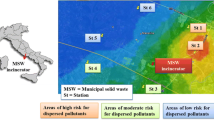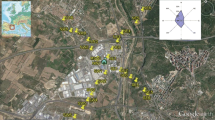Abstract
The aim of the study was to evaluate the airborne contamination by polycyclic aromatic hydrocarbons (PAHs) and some heavy metals (arsenic [As], cadmium [Cd], chromium [Cr], copper [Cu], nickel [Ni], lead [Pb], and zinc [Zn]) of different pollution scenarios around a solid-waste landfill in central Italy using the lichen Pseudovernia furfuracea as a monitoring tool. For this purpose, eight stations around a landfill characterized by different air pollution sources (industrial, agricultural, residential areas, and roads with different traffic intensities), together with three stations far from the landfill (control areas), were monitored using a set of 22 lichen samples (11 samples analysed for PAHs and metals after 4 months, and 11 samples analysed for metals after 8 months). After 4 months of exposure, the lichen content of all of the analysed elements was greater than that in the pre-exposed lichens. In addition, the Cu and Pb concentration after 8 months was greater than the level after 4 months. The order of metal concentration was Zn > Pb > Cu (or Cu > Pb) > Cr > Ni > As > Cd in all cases. The range of ∑11PAHs concentration was 634–1,371 ng/g dw (three to seven times greater than the amount in the pre-exposed lichens). The ∑11PAHs were dominated (>70 %) by compounds with three aromatic rings. The comparison of the levels of air pollutants among the monitored stations shows nonrelevant spatial patterns between the landfill stations and the control areas; the levels of PAHs and metals found in the lichen samples around the landfill seemed to be more related to the general diffusion of these pollutants in that area.


Similar content being viewed by others
References
Augusto S, Pereira MJ, Soares A, Branquinho C (2007) The contribution of environmental biomonitoring with lichens to assess human exposure to dioxins. Int J Hyg Environ Health 210:433–438
Augusto S, Máguas C, Matos J, Pereira MJ, Branquinho C (2010) Lichens as an integrating tool for monitoring PAH atmospheric deposition: a comparison with soil, air and pine needles. Environ Pollut 158:483–489
Augusto S, Máguas C, Branquinho C (2013) Guidelines for biomonitoring persistent organic pollutants (POPs), using lichens and aquatic mosses–a review. Environ Pollut 180:330–3388
Bajpai R, Mishra GK, Mohabe S, Upreti DK, Nayaka S (2011) Determination of atmospheric heavy metals using two lichen species in Katni and Rewa cities, India. J Environ Biol 32:195–199
Baptista MS, Vasconcelos MT, Cabral JP, Freitas MC, Pacheco AM (2008) Copper, nickel and lead in lichen and tree bark transplants over different periods of time. Environ Pollut 151:408–413
Bargagli R, Nimis PL (2002) Guidelines for the use of epiphytic lichens as biomonitors of atmospheric deposition of trace elements. In: Nimis PL, Scheidegger C, Wolseley PA (eds) Monitoring with lichens: monitoring lichens. Kluwer Academic, Dordrecht, pp 295–299
Bari A, Rosso A, Minciardi MR, Troiani F, Piervittori R (2001) Analysis of heavy metals in atmospheric particulates in relation to their bioaccumulation in explanted Pseudevernia furfuracea thalli. Environ Monit Assess 69:205–220
Bergamaschi L, Rizzio E, Giaveri G, Loppi S, Gallorini M (2007) Comparison between the accumulation capacity of four lichen species transplanted to an urban site. Environ Pollut 148:468–476
Blasco M, Domeño C, Nerín C (2008) Lichens biomonitoring as feasible methodology to assess air pollution in natural ecosystems: combined study of quantitative PAHs analyses and lichen biodiversity in the Pyrenees Mountains. Anal Bioanal Chem 391:759–771
Brunialti G, Frati L (2007) Biomonitoring of nine elements by the lichen Xanthoria parietina in Adriatic Italy: a retrospective study over a 7-year time span. Sci Total Environ 387:289–300
Chrysikou L, Gemenetzis P, Kouras A, Manoli E, Terzi E, Samara C (2008) Distribution of persistent organic pollutants, polycyclic aromatic hydrocarbons and trace elements in soil and vegetation following a large scale landfill fire in Northern Greece. Environ Int 34:210–225
Conti ME, Cecchetti G (2001) Biological monitoring: lichens as bioindicators of air pollution assessment–a review. Environ Pollut 114:471–492
El-Fadel M, Findikakis A, Leckie J (1997) Environmental impacts of solid waste landfilling. Environ Manage 50:1–25
Eurostat (2012) Environment in the EU27 Landfill still accounted for nearly 40 % of municipal waste treated in the EU27 in 2010. Eurostat Press Office http://europa.eu/rapid/press-release_STAT-12-48_en.htm. Accessed 10 November 2012
Frati L, Brunialti G, Loppi S (2005) Problems related to lichen transplants to monitor trace element deposition in repeated surveys: a case study from central Italy. J Atmos Chem 52:221–230
Gjorgieva D, Kadifkova-Panovska T, Bačeva K, Stafilov T (2011) Assessment of heavy metal pollution in Republic of Macedonia using a plant assay. Arch Environ Contam Toxicol 60:233–240
Guidotti M, Stella D, Owczarek M, De Marco A, De Simone C (2003) Lichens as polycyclic aromatic hydrocarbons bioaccumulators used in atmospheric pollution studies. J Chromatogr A 985:185–190
Guidotti M, Stella D, Dominici C, Blasi G, Owczarek M, Vitali M et al (2009) Monitoring of traffic-related pollution in a province of central Italy with transplanted lichen Pseudovernia furfuracea. Bull Environ Contam Toxicol 83:852–858
Koshy L, Jones T, BéruBé K (2009) Characterization and bioreactivity of respirable airborne particles from a municipal landfill. Biomarkers 14(Suppl 1):49–53
Loppi S, Pirintsos SA (2003) Epiphytic lichens as sentinels for heavy metal pollution at forest ecosystems (central Italy). Environ Pollut 121:327–332
Nali C, Balducci E, Frati L, Paoli L, Loppi S, Lorenzini G (2007) Integrated biomonitoring of air quality with plants and lichens: a case study on ambient ozone from central Italy. Chemosphere 67:2169–2176
Ng OH, Tan BC, Obbard JP (2005) Lichens as bioindicators of atmospheric heavy metal pollution in Singapore. Environ Monit Assess 123:63–74
Paoli L, Corsini A, Bigagli V, Vannini J, Bruscoli C, Loppi S (2012) Long-term biological monitoring of environmental quality around a solid waste landfill assessed with lichens. Environ Pollut 161:70–75
Porta D, Milani S, Lazzarino AI, Perucci CA, Forastiere F (2009) Systematic review of epidemiological studies on health effects associated with management of solid waste. Environ Health 8:60
Scerbo R, Ristori T, Possenti L, Lampugnani L, Barale R, Barchigiani C (2002) Lichen (Xanthoria parietina) biomonitoring of trace elements contamination and air quality assessment in Pisa province (Tuscany, Italy). Sci Total Environ 286:27–40
Shukla V, Upreti DK (2009) Polycyclic aromatic hydrocarbon (PAH) accumulation in lichen, Phaeophyscia hispidula of DehraDun city, Garhwal Himalayas. Environ Monit Assess 149:1–7
Sorbo S, Aprile G, Strumia S, Castaldo Cobianchi R, Leone A, Basile A (2008) Trace element accumulation in Pseudevernia furfuracea (L.) Zopf exposed in Italy’s so called triangle of death. Sci Total Environ 407:647–654
Špirić Z, Vučković I, Stafilov T, Kušan V, Frontasyeva M (2013) Air pollution study in Croatia using moss biomonitoring and ICP-AES and AAS analytical techniques. Arch Environ Contam Toxicol 65:33–46
Treweek J (1999) Ecological impact assessment. Blackwell Science, Oxford
U.S. EPA (2010) Municipal solid waste generation, recycling, and disposal in the United States: Facts and figures for 2010. United States Environmental Protection Agency. http://www.epa.gov/osw/nonhaz/municipal/pubs/msw_2010_rev_factsheet.pdf. Accessed 10 Nov 2012
Uluozlu OD, Kinalioglu K, Tuzen M, Soylak M (2007) Trace metal levels in lichen samples from roadsides in East Black Sea region, Turkey. Biomed Environ Sci 20:203–207
Wester-Herber M (2004) Underlying concerns in land-use conflicts—the role of place-identity in risk perception. Environ Sci Pollut 7:109–116
Yang SYN, Connell DW, Hawker DW, Kayal SY (1991) Polycyclic aromatic hydrocarbons in air, soil and vegetation in the vicinity of an urban roadway. Sci Tot Environ 102:229–240
Zhou J, Wang T, Huang Y, Mao T, Zhong N (2005) Size distribution of polycyclic aromatic hydrocarbons in urban and suburban sites of Beijing, China. Chemosphere 61:792–799
Author information
Authors and Affiliations
Corresponding author
Rights and permissions
About this article
Cite this article
Protano, C., Guidotti, M., Owczarek, M. et al. Polycyclic Aromatic Hydrocarbons and Metals in Transplanted Lichen (Pseudovernia furfuracea) at Sites Adjacent to a Solid-waste Landfill in Central Italy. Arch Environ Contam Toxicol 66, 471–481 (2014). https://doi.org/10.1007/s00244-013-9965-6
Received:
Accepted:
Published:
Issue Date:
DOI: https://doi.org/10.1007/s00244-013-9965-6




